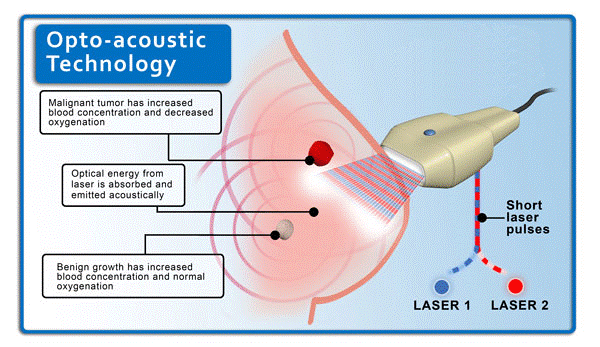Optoacoustic Breast Imaging Technology May Help Reduce Negative Biopsies for Breast Cancer
By MedImaging International staff writers
Posted on 30 Dec 2013
A new breast imaging technique called optoacoustics combines technology based on the photoacoustic effect with conventional ultrasound. Posted on 30 Dec 2013
The optoacoustic images provide a unique blood map in and around suspicious breast masses. Unlike other imaging modalities, the system does not expose patients to potentially harmful ionizing radiation or injectable contrast agents.

Image: Optoacoustic imaging combines light and sound to produce high-resolution, high-contrast images to indicate the presence of angiogenesis. Malignant tumor has increased blood concentration and decreased oxygenation (top) ; Optical energy is absorbed and emitted acoustically (middle); Benign growth has increased blood concentration and normal oxygenation (bottom) (Photo courtesy of Seno Medical Instruments).
Seno Medical Instruments, Inc. (San Antonio, TX, USA), a company that develops optoacoustic imaging as a tool to improve the process of diagnosing breast cancer, reported on early promising data from a feasibility study of its Imagio breast imaging device. The feasibility study findings suggest that information from this technology, beyond that available from traditional breast ultrasound, may be helpful in helping physicians in their decisions whether to recommend biopsies for women with suspicious breast masses. The data were presented December 2013 at the annual meeting of the Radiological Society of America (RSNA), held in Chicago (IL, USA).
“Given these early results, I believe that optoacoustics could potentially spare some BI-RADS 4a cases and some BI-RADS 4b cases from needing to undergo biopsies,” said study investigator Kenneth Kist, MD, associate professor of radiology at the University of Texas (UT) Health Science Center (San Antonio, USA). “This could represent a significant advance in the diagnostic path for breast cancer and I look forward to seeing the results of the ongoing US pivotal study.”
The BI-RADS classification is used by radiologists to predict the probability of malignancy of a breast mass based on imaging results. A BI-RADS 3 mass only carries up to a 2% risk of being cancerous. Patients with masses in the BI-RADS 3 category can safely wait to see if the mass changes or grows. A BI-RADS 4a mass is considered to have more than a 2% but less than or equal to 10% chance of being cancerous, and a BI-RADS 4b mass is believed to carry from greater than 10% to less than or equal to 50% risk of malignancy. Patients whose masses are deemed BI-RADS 4a or higher usually undergo a core needle procedure or surgical biopsy.
For this study, five blinded readers independently assessed Imagio images from 73 patients with 74 breast masses. All of the masses were biopsied to provide a gold-standard comparator. Readers were blinded to the patients’ biopsy report, medical history, histology report, clinical records, and follow-up. All 34 identified cancer masses remained at their original BI-RADS classification. In the 40 remaining benign masses, downgrades to BI-RADS 3 were achieved in 12 of 22 original BI-RADS 4a diagnoses as a result of optoacoustics. Three of 13 BI-RADS 4b masses were downgraded to BI-RADS 3.
“These early results underscore the potential of optoacoustic imaging technology which we believe represents a significant step forward in cancer diagnosis,” said Thomas Stavros, MD, FACR, FSRU, FRANZCR, medical director, Seno Medical Instruments. “This feasibility study shows that Imagio has potential to lead to better outcomes for women and fewer biopsies. We are working diligently with 16 leading breast imaging centers across the US to complete our Imagio pivotal study that will form the basis of our premarket approval application [PMA] with the US Food and Drug Administration.”
Seno Medical Instruments, Inc. is a medical imaging company focused on the development and marketing of opto-acoustic imaging. Seno’s Imagio breast imaging system employs opto-acoustic technology co-registered with ultrasound to generate functional and anatomic images of the breast. The resulting images provide a unique blood map around suspicious breast masses while the ultrasound provides a traditional anatomic image. Through the appearance or absence of the two characteristic indicators of cancer--angiogenesis and deoxygenation, Seno spokespersons believe that Imagio images will be a more effective tool to help radiologists confirm or rule out malignancy than current diagnostic imaging modalities--without exposing patients to potentially harmful ionizing radiation or contrast agents. Seno’s platform technology may also address other disease applications.
Related Links:
Seno Medical Instruments














